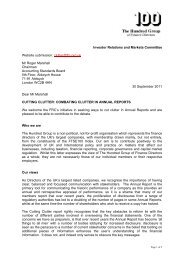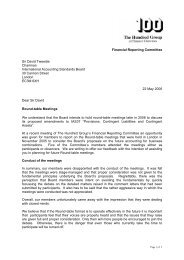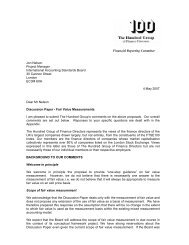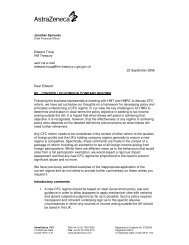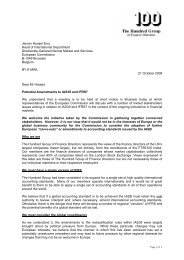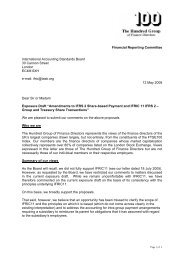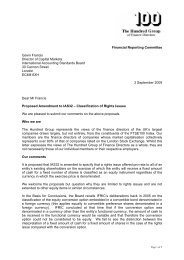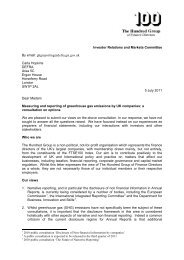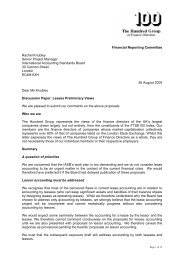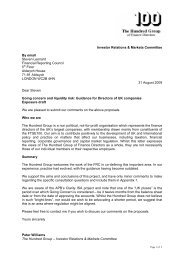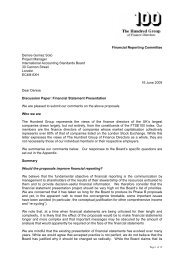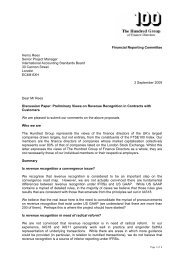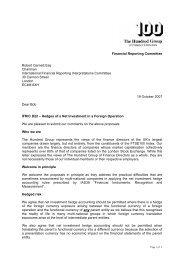Financial Reporting Committee Joan Brown Project Manager ...
Financial Reporting Committee Joan Brown Project Manager ...
Financial Reporting Committee Joan Brown Project Manager ...
You also want an ePaper? Increase the reach of your titles
YUMPU automatically turns print PDFs into web optimized ePapers that Google loves.
We do not support this aspect of the proposals on two grounds. Firstly, the notion of the risk<br />
adjustment assumes a degree of accuracy that cannot realistically be applied to what are<br />
inherently uncertain estimates. Secondly, the Board does not provide any meaningful<br />
guidance on how to assess the risk assessment and, by the Board’s own admission in<br />
paragraph 36C, an entity may anyway be unable to transfer the obligation to a third party.<br />
We therefore sympathise with the views of the six Board members who expressed their<br />
disagreement with the application of the risk margin.<br />
Associated costs<br />
We note that paragraph 36D states that the amount that an entity would pay to cancel or<br />
transfer an obligation includes any associated costs. In the context of obligations fulfilled by<br />
the entity, paragraph B7 states that relevant outflows include “associated costs such as<br />
external legal fees or the costs of an in-house legal department attributable to that<br />
obligation”.<br />
We believe that the provision should include those incremental costs that are directly<br />
attributable to fulfilling, cancelling or transferring the obligation. We do not believe that it is<br />
appropriate to include allocated overhead costs. We suggest that this is made clear in the<br />
final standard and that the guidance on associated costs applies irrespective of whether the<br />
costs are incurred in relation to fulfilling, cancelling or transferring the obligation.<br />
Fair value?<br />
We understand that one of the Board’s main reasons for replacing IAS 37 is that the basis of<br />
accounting for contingent liabilities contained in IAS 37 is inconsistent with that contained in<br />
IFRS 3 (Revised 2008) ‘Business Combinations’. We do not believe that it is necessary to<br />
replace IAS 37 for this reason because there are inconsistencies between the basis of<br />
measuring other assets and liabilities when acquired in a business combination and in other<br />
situations (the obvious example being intangible assets).<br />
Moreover, IFRS 3 requires that liabilities should be measured at fair value. While we<br />
understand that the Board does not intend that liabilities should always be measured at fair<br />
value in other situations, we are concerned that the proposed basis of measurement could<br />
easily be confused with fair value. We therefore recommend that the Board makes clear the<br />
differences between the proposed basis of measurement of liabilities and the proposals<br />
contained in its recent exposure draft entitled ‘Fair Value Measurement’.<br />
Question 2 – Obligations fulfilled by undertaking a service<br />
Some obligations within the scope of IAS 37 will be fulfilled by undertaking a service<br />
at a future date. Paragraph B8 of Appendix B specifies how entities should measure<br />
the future outflows required to fulfil such obligations. It proposes that the relevant<br />
outflows are the amounts that the entity would rationally pay a contractor at the future<br />
date to undertake the service on its behalf.<br />
Paragraphs BC19-BC22 of the Basis for Conclusions explain the Board’s rationale for<br />
this proposal.<br />
Do you support the proposal in paragraph B8? If not, why not?<br />
Paragraph B8 proposes that where the entity fulfils an obligation by providing a service, it<br />
should measure the liability based on the amount that a contractor would charge it to perform<br />
the service on the entity’s behalf or, if there is no market for the service, based on the<br />
amount it would charge another party to undertake the service. An example of such a<br />
situation would be an oil company that decommissions its own drilling rigs.<br />
Page 8 of 9



